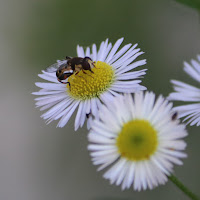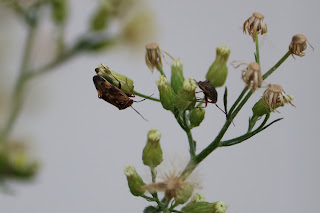If you caught the post about the recent trash cleanup on the Greenway last week, you may have noticed that a huge amount of the litter picked up was beverage containers: pop bottles, beer cans, energy drink cans, sports drink bottles, and more than anything flimsy water bottles by the dozen.
If you spend much time detrashing roadsides around your neighborhood, you can probably attest to the same. Modelo cans and Busch Light bottles spring up like mushrooms...and how the heck are there so many cups from the Wendy's almost a mile away?
This blog has been complaining (venting?) about litter along the Greenway and elsewhere for years. Litter is highly visible—to those who are around to see it. But for many people, a can or bottle here and there scarcely registers as they speed along in vehicles. There is an assumption that litter-prevention programs like our Bottle Bill are no longer necessary, because we have curbside recycling programs that take care of the problem. They claim it's an obsolete law, a relic from a simpler time that doesn't work for today's world. Is it?
 |
| A sampling of the beverage containers from the latest Greenway cleanup. |
Hardly. It's more necessary now than ever. There are more cans, more bottles, more different drinks sold in those small containers than ever before. And they're still often consumed far from trash cans and recycle bins. And they still find their way onto roadsides and public spaces in huge numbers. The Iowa City Litter Crew collects data from cleanups on Open Litter Map, an open tracking system that lets users upload and tag photos of litter they encounter, and provides just a glimpse of the scale of the problem, in hard data.
 |
| Each of the green dots is a piece of litter that has been picked up and tagged. |
Anyone can download the global data from Open Litter Map and create their own visualizations, like this one showing deposit vs. non-deposit containers picked up in Iowa City (if the map below doesn't show you can click here to open it):
Expand those hundreds of icons to other areas of Iowa City; to the metro region; to other cities in Iowa; to busy stretches of highway between those cities...and you can begin to see the scale of the problem.
Iowa's Bottle Bill created a financial incentive to ensure that cans and bottles found their way to proper disposal. The problem is that the law has been rendered ineffective, either through neglect or through a willful effort to undermine it at the behest of, let's say, those who aren't out there picking up litter on the roadsides with us every week.
For one thing, a nickel ain't worth what it used to be. Plug $.05 into an inflation calculator and you'll find that a deposit would need to be $.22—almost a quarter!— to have the same impact in 2024 as it did when the law was passed. In 1979, you could collect five bottles to redeem, and with the quarter you received you could buy yourself a nice candy bar. Today? You'd need to collect 36 bottles!*
 |
| One of the 50+ water bottles collected at the last cleanup. |
And those updates clearly make a difference. A 2022 report shows that only 49% of Iowa's deposit containers are recovered. And while that is significantly better than the 25% recovery for non-deposit containers nationally, it lags far behind states that have more robust programs (Oregon, with a 10-cent deposit and a robust redemption infrastructure, leads the way with a whopping 86% recovery rate).
I'd like to assign every legislator, every citizen, who believes the Bottle Bill to be unnecessary a stretch of busy road to keep clean. I'd ask them to log the litter they find on Open Litter Map, and review the data for their patch and other areas around town to see exactly how pervasive the problem is. And then I'd ask those lawmakers to increase the deposit to a quarter (though I'd be willing to settle for a dime) and include water bottles and sports drinks. I'd ask them to make sure redemption is simple and fast, and I'd ask them to use funds from unredeemed containers for neighborhood cleanup efforts.
And yes, with the current legislators in our state that may be a fantasy. But when we document the problem, we are creating data that other decision-makers can use in support of solving a problem at its source—the industry that creates the waste and the people who consume the products—instead of leaving it to be handled by regular folks who just want to keep their neighborhoods clean.
You can help collect that data as well: it's as simple as snapping a photo with your phone and uploading to the Open Litter Map, tagging it with the type of litter and brand. Check out the Quick Start Guide the IC Litter Crew has put together for a walk-through, or attend a meetup with the group.
*Economists may note that the size of a candy bar has increased since 1979 as well, from an average 1.2 ounces in 1978 to 1.55 ounces for a Hershey bar today. Adjusted for that size difference, you'd still need to collect a whopping 28 containers at a nickel apiece to buy a candy bar of the same size as a 1979 bar.
Resources/Additional Reading:
- The Decline of Refillable Beverage Bottles in the U.S. (CRI)
- https://www.candywrapperarchive.com/candy-collector/candy-prices-over-the-years/
- State Beverage Container Deposit Laws (NCSL)
- 2022 Recovery Rate Report for Deposit Beverage Containers (Iowa DNR)


















































